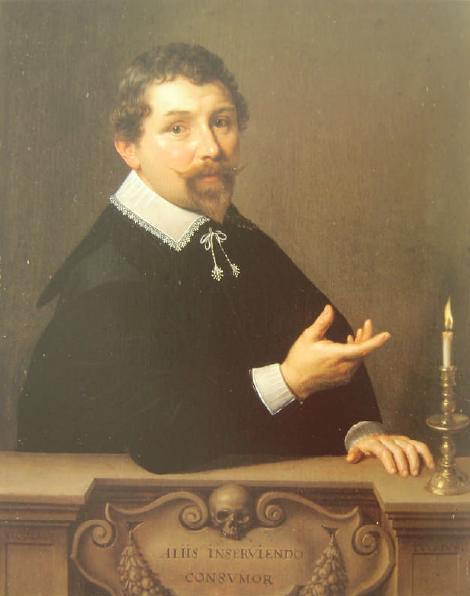On October 9, 1593, Claes Pieterszoon was born in Amsterdam. He came from a prosperous family, and grew up to become a doctor. He built himself a house in 1616, and named it De Tulp, after tulips. He evidently liked tulips quite a lot, because the next year he also changed his own name to Nicolaes (a more formal version of Claes) Tulp.
Tulp became a well-known physician, and and also became the city treasurer of Amsterdam, and then in 1622 became a magistrate, which is a kind of administrative judge. His reputation in medicine grew as well, and he was appointed Praelector Anatomiae (chief surgeon) by the Amsterdam Guild of Surgeons. As Praelector Anatomiae, Tulp had a number of official duties, including signing the fitness reports for the Dutch colonists who traveled to settle Manhattan Island in the New World. You can still see his signature on their archives, which were rediscovered in the basement of the New York public library in the 1980s.
Tulp was also responsible for inspecting the apothecary shops in Amsterdam — there were 66 of them in 1636. He was concerned about the high prices they charged, especially for “medicines” that as a physician, he knew to be useless. SO he organized the Guild of Surgeons and they created the Pharmacopoea Amstelredamensis. It was a list of medicines, along with rules about pricing. It was the first pharmacopoeia in Holland, and the Guild required that if you wanted to open an apothecary shop, you had to study it and pass an exam. Other cities in Holland followed Tulp’s example.
In 1641 Tulp published Observationes Medicae, a book describing 231 cases of disease and death he had personally encountered. He also included illustrations and descriptions of animals brought back to Europe by Dutch East India Company ships, as well as including some of the (often outlandish) stories related by some of the sailors. One particularly odd tale was about a barber-surgeon on a Dutch ship who performed bladder surgery on himself — and survived. Tulp also described the effects of tobacco smoking on lungs, migraines, the placebo effect, and a valve in the human gastrointestinal system still known as Tulp’s valve.
He wrote other books as well, and even became the Mayor of Amsterdam in 1654, and stayed in office for four terms. Perhaps most surprising, for a 17th- century person, we know what Tulp looked like. That’s because he’s the subject of a well-known painting by Rembrandt, The Anatomy Less on Dr. Nicolaes Tulp. The painter Nicolaes Eliasz also painted Tulp’s portrait when he was a city magistrate.
There are more paintings of Tulp in Amsterdam, as well as several statues of him. In many ways it took the rest of Europe centuries to catch up to some of Tulp’s innovations in Amsterdam.

Nicolaes Tulp, 1639, by Nicolaes Eliaszoon Pickenoy
